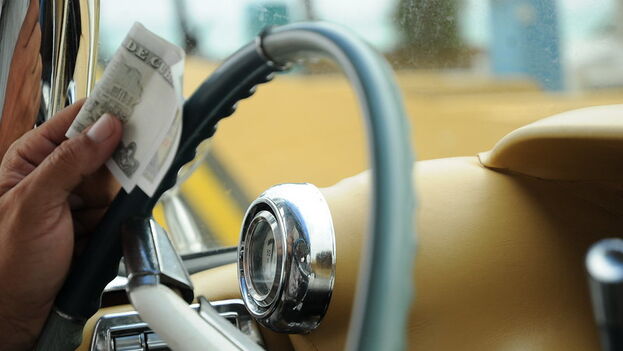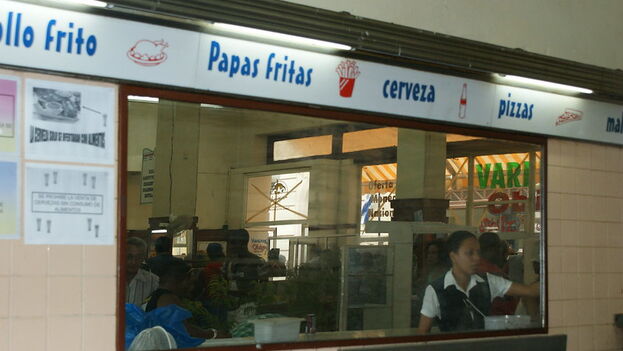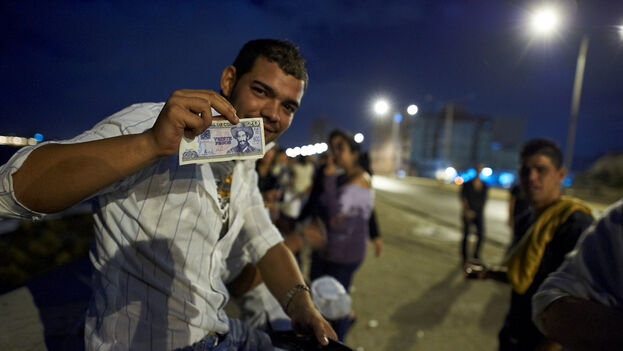
![]() 14ymedio, Marcelo Hernández, Havana, 6 March 2020 — “It’s 985 pesos,” the employee says when she brings the bill for a lunch for three people in a state restaurant in the municipality of Playa, in Havana. It exceeds the monthly salary of one of the customers, an engineer, who does not like the payment in CUP (Cuban pesos). “It is now more obvious than ever that prices have nothing to do with wages,” he complains.
14ymedio, Marcelo Hernández, Havana, 6 March 2020 — “It’s 985 pesos,” the employee says when she brings the bill for a lunch for three people in a state restaurant in the municipality of Playa, in Havana. It exceeds the monthly salary of one of the customers, an engineer, who does not like the payment in CUP (Cuban pesos). “It is now more obvious than ever that prices have nothing to do with wages,” he complains.
Last week the Ministry of Internal Trade announced that the food services under state management can only use one currency, the CUP. Products that were previously sold in Cuban convertible pesos (CUC) such as beers, soft drinks, cigars, water, ice cream, jams and other alcoholic beverages, have been priced in Cuban pesos.
The measure has triggered uncertainty about the possible short-term disappearance of the CUC, which has been losing ground since the authorities warned that the survivor of monetary unification was going to be the Cuban peso.
Since 1994 two currencies have coexisted and people have become accustomed to alternating between the devalued Cuban peso (CUP), which the state uses to pay salaries and people use to buy basic products and services; and the convertible peso (CUC), comparable to the dollar.
During the Government of Raúl Castro, from 2008 to 2018, there was much talk about monetary unification and that it would be done gradually, but to date the schedule or the moment of completion of the process has not been revealed, much less what the exchange rate will be.
“We are still getting used to this new situation,” acknowledges an employee of a small state-owned store that strives to apply the new directives that, since last week, prohibit her from charging customers in CUCs. In the business, located next to the Habana Libre hotel, food combos with pork, rice and some vegetable are sold, as well as alcoholic drinks and soft drinks. “The simple fact of calculating the income at the end of the day is already a problem because the numbers [in CUPs] are larger and errors can increase, especially when you have been working in CUCs for so many years.”
“The Cuban peso is easier to counterfeit because the paper used for many denominations is of worse quality, so we must keep our eyes peeled because people have already tried to pass some bills that were not authentic,” she adds. “Now I get a chill when I have to give a user a bill in Cuban pesos and the amount is greater than what I earn a whole month working here; before I didn’t realize it so much,” said the worker.
At a table, an Italian tourist talks with two young Cubans. They have each ordered a plate of fried pork dough, accompanied by a Belgian beer which is the only one available these days due to poor national production. Vicenzo, who lives in Milan, says that every year he comes to Cuba once or twice and that managing in CUPs bothers him.
“If before I had to change my euros into CUCs, now I also have to, then, change my CUCs into CUPs because there are services — like Panataxis — that remain exclusively in convertible pesos, while to eat or drink I need the Cuban currency [CUPs], and I’m confused the whole time… I have to go out and exchange money because I don’t have enough [in CUPs],” Vincenzo laments, when the bill arrives for 412 CUP.
The employee comments to 14ymedio that the scene is repeated almost every day. “There are people who do not know, they come, they eat and drink, and then they do not have the correct currency to pay.” A few meters away, a clever black market entrepreneur has found his niche in that difficulty. “I change 1 to 22 right now without having to an exchange kiosk,” he offers, instead of the 24 pesos of the official CUC exchange rate.

“Although the ’chavitos’* cannot be used here , they are still the strong currency in stores and other services, so it is convenient for me to have them,” explains the money changer. “Most of the people who accept this change are tourists, Cuban-Americans or people who don’t want to have to interrupt a lunch or a meal to change money to pay the bill.”
While the state sector is obliged to respect the new measure, in private businesses they are more flexible. “It doesn’t matter if you pay in euros, dollars, convertible pesos or Japanese yen,” says Eduardo Rodríguez, the driver of a private car that makes frequent trips from Havana to Varadero or to the Viñales tourist area. “As long as it is money there is no problem.”
However, drivers of collective taxis that run on fixed routes within the city prefer to be more cautious. “I do not accept the chavito,” warns the self-employed worker at the helm of an old patched-up Cadillac that carries passengers between the Capitol and the town of Marianao.

“I can’t risk ending up with too many convertible pesos and then they suddenly unify the currency and only allow each person to exchange a small amount ,” he explains. “The same day they announced that the state cafeterias and restaurants were only going to accept CUPs, I decided to do the same inside my car, because that is a sign that cannot be ignored.”
However, after the initial announcement, the Deputy Minister of the Ministry of Internal Trade, Miriam Pérez, warned that sales in convertible pesos in the establishments of the state system of commerce and food services, are not related to monetary unification but are intended to create “greater control” in that commercial network. Some statements that have failed to placate the suspicions around the chavito.
“Sure, what would they say? If they publicly announce that this currency is already a corpse, nobody will want to have it in their pocket,” says Eduardo Rodríguez. “It is a danger to be saving money in chavitos because any day we could wake up with the news that they are useless, although my children and grandchildren were born with this currency and for them they were the bills that were really worth something because the other [CUPs] weren’t good for much.”
“It is not the same to say that a pizza is worth 3.50 CUCs when you put in front of the customer and then when he gets the bill he owes almost 90 CUP,” explains Wilfredo, a waiter in a state-run restaurant in Playa specializing in Italian food. “The number in Cuban pesos impresses anyone.”
*Translator’s note: “Chavito” is a slang term for a Cuban convertible peso, of disputed origin, but it is said to be a play on the name of the former Venezuelan president, Hugo Chavez.
______________________
COLLABORATE WITH OUR WORK: The 14ymedio team is committed to practicing serious journalism that reflects Cuba’s reality in all its depth. Thank you for joining us on this long journey. We invite you to continue supporting us by becoming a member of 14ymedio now. Together we can continue transforming journalism in Cuba.
